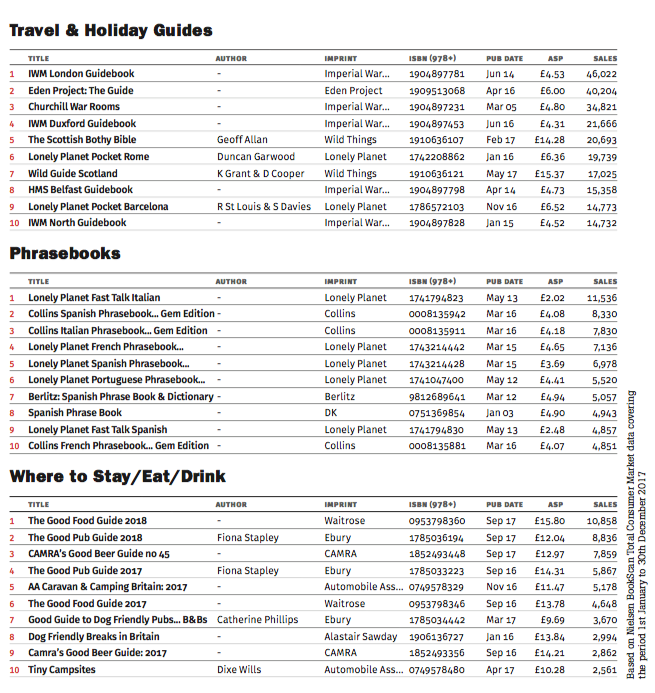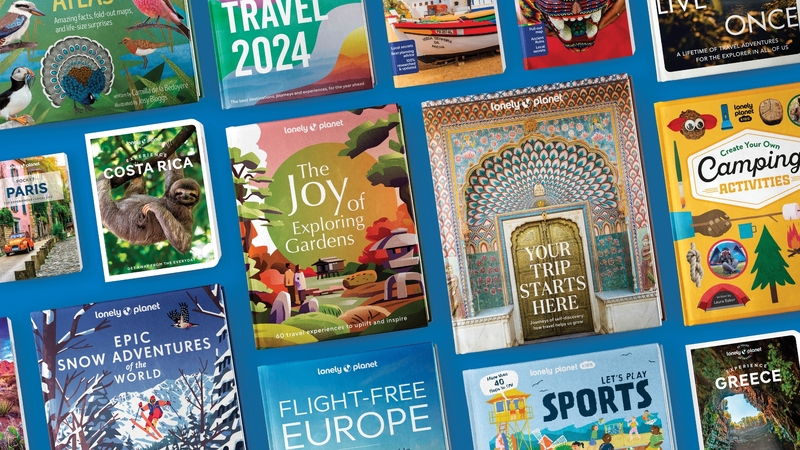You are viewing your 1 free article this month. Login to read more articles.
Travel market takes a wrong turn
It was not a vintage year for the Atlases, Maps & Travel category. Despite inching up in value in both 2015 and 2016, the sector as a whole fell 2.3% year on year in 2017, dropping 3.5% in volume. At 6.17 million books sold for £58.48m, Atlases, Maps & Travel hit all-time lows in both volume and value, with every single sub- category declining year on year.
The only measure by which the category did rise was average selling price, which ballooned 12p to £9.46. Over the past three years, the a.s.p. of a title in the Atlases, Maps & Travel category has gone up by nearly £1, which probably explains the encouraging value figures over 2015 and 2016.
Though this is dismal news for the travel category, some comfort might be taken in the fact that the decline is, at least, not as dramatic as it once was. While value has fallen 7.6% in the past five years, most of that drop happened between 2012 and 2013, when it crashed 6.3%. Since then, value has remained fairly steady, around the £58m–£59m mark.
With the ubiquity of Google Maps and sat navs, it isn’t really surprising to note that print maps are in terminal decline. The Road Atlases & Maps sub-category last year sold a third of the number of units it shifted at its peak in 2006, slumping from 1.7 million in volume to 532,005. Street Maps & City Plans, once worth £8.4m, have now declined to £2.2m. General Folded Maps & Walking Guides, the category’s map powerhouse, could see a light at the end of the tunnel in 2016—it jumped nearly 3% in volume. But 2017 saw that light cruelly snuffed out—it dropped 2% year on year. However, value held up fairly well, only declining 0.8% and, at £11.98m, it was the category’s second-highest figure in the past five years.
Other sub-categories that have performed relatively strongly in recent years also nosedived in 2017. Travel & Holiday Guides saw something of a renaissance in 2016, jumping 3.15% to top £35m for the first time in three years, but last year it dropped 0.77%. It was the shallowest decline of all the Atlases, Maps & Travel sub-categories, but a decline nonetheless.
Most surprisingly, Phrasebooks— which leapt 3.87% in value in 2015, and posted three years of incredibly consistent volumes, within 1,000 copies of one another— suddenly crashed by 8.5% in value, selling 17,212 fewer copies year on year. The sub-category posted its all-time lowest figures in both volume and value.
In the travel category’s top 20 for 2017, even maps edged out language guides, despite their overall decline. Back in 2016, one phrasebook (Lonely Planet Spanish Phrasebook & Dictionary) made the grade, but last year Lonely Planet Spanish nearly halved in volume, to be replaced by Lonely Planet Fast Talk Italian in the Phrasebook sub-category’s top spot. (This could be linked to a Roman resurgence—Lonely Planet Pocket Rome leapt 10% in volume year on year.)

The right path
UK-based tourist attractions enjoyed a boost in 2017, with guidebooks to the Imperial War Museum, the Eden Project and the Churchill War Rooms rocketing in volume. IWM London Guidebook held the Atlases, Maps & Travel category’s number one spot from the year before, with an extra 9,000 copies sold year on year. The IWM Duxford Guidebook also leapt up the chart, to place fourth. The HMS Belfast Guidebook and IWM North Guidebook were also in the top 10, which contained eight UK-based titles.
Scotland suddenly outnumbered Rome and Barcelona in the top 20, with The Scottish Bothy Bible scoring a strong fourth place, selling 20,693 copies, and Wild Guide Scotland in seventh, with 17,025 copies sold.
Internationally, the UK book-buying public’s brief dalliance with far-flung locations in 2016—possibly as a reaction to Brexit or the state of the pound against the Euro—came to an end, as Lonely Planet Cuba and Lonely Planet Japan dropped out of the top of the chart, to the benefit of Lonely Planet Pocket Barcelona and DK Eyewitness Top 10: Venice.
A big beast slain in 2017 was New York—the DK Eyewitness Top 10: New York City slumped from sixth to 17th place, and the Brit Guide to Orlando suffered similarly, dropping out of the overall top 20 altogether. Much as we might try, we can’t blame Donald Trump for everything—as a wider trend, this probably points to cash-strapped Brits opting to holiday at home. Perhaps US travel guides are suffering from the same strain of book-buyers’ anti-Americanism which has seen George Saunders’ Man Booker 2017 winner Lincoln in the Bardo fail to set the charts alight.
The Travel Writing sub-category resides in a different corner of Nielsen BookScan, under the umbrella of The World/Ideas/Culture. However, it followed a similar trajectory to the Atlases, Maps & Travel category, falling by nearly a third in volume and 19% in value year on year, after steady results across 2015 and 2016. This time, the explanation is a lot simpler: Bill Bryson’s The Road to Little Dribbling was released in hardback in 2015 and paperback in 2016, selling 640,000 copies across all editions.















